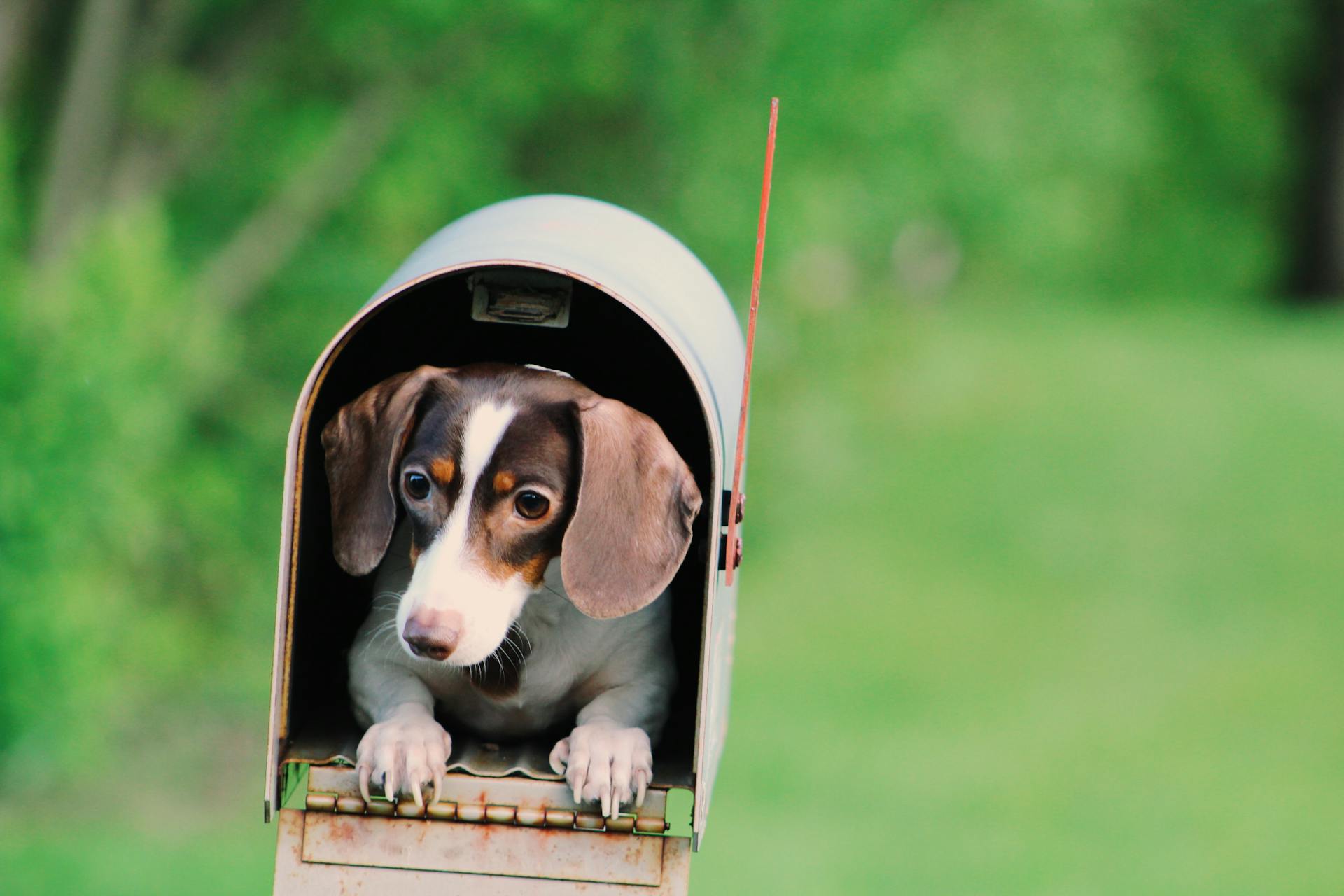
Dogs eating peppermint candy can be a fun surprise, but it's essential to know the risks involved.
Mint candies can be toxic to dogs due to the presence of xylitol, a sugar substitute commonly used in sugar-free products.
Some dogs may experience vomiting, diarrhea, or lethargy after consuming peppermint candy, while others might not show any symptoms at all.
Expand your knowledge: Dogs Eating Candy Canes
Dangers of Feeding Peppermint to Dogs
Feeding peppermint to dogs can be hazardous to their health. Even a small amount of xylitol, a common ingredient in sugar-free peppermint candies, can cause severe symptoms like vomiting, seizure, and collapse.
Dogs may also experience stomach upset due to the high peppermint content in candies, which can lead to vomiting or diarrhea. This is especially true if your dog isn't accustomed to eating peppermint.
The risk of choking is also a concern, as peppermint candies can break into sharp pieces, damaging your dog's throat and stomach. Additionally, the individually wrapped plastic can cause blockages in your dog's digestive tract.
Here are some specific risks associated with feeding peppermint to dogs:
- Xylitol poisoning from sugar-free candies
- Stomach upset from high peppermint content
- Choking hazard from broken candy pieces
- Blockages from individually wrapped plastic
In severe cases, toxicity can occur as quickly as 15 minutes after ingestion, causing life-threatening low blood sugar levels and potentially leading to liver failure. It's essential to keep peppermint candies out of reach of your furry friends to avoid these risks.
What to Do If Your Dog Eats Peppermint
If your dog eats peppermint candy, there are a few things you need to know. First, dogs are at risk of xylitol poisoning, which can have severe consequences, including vomiting, seizure, collapse, and lethargy.
Even a small amount of xylitol can be toxic, so it's essential to act quickly. Call your veterinarian if you suspect your dog may have eaten peppermint candy, and they'll let you know if you need to bring your pup in or take them to an emergency vet.
You can also call the Pet Poison Helpline at 1-855-764-7661 for assistance. They answer calls 24/7 to ensure your dog stays happy and healthy.
In addition to xylitol poisoning, peppermint candy can also cause stomach upset in dogs, especially if they're not accustomed to it. This can lead to vomiting or diarrhea as your dog's body tries to expel the foreign object.
If your dog eats peppermint candy, be aware of the potential choking hazard and sharp edges. These can damage your dog's throat and stomach, causing serious harm.
Here are some key things to watch out for if your dog eats peppermint candy:
- Vomiting or diarrhea
- Loss of appetite
- Constipation
- Xylitol poisoning (vomiting, seizure, collapse, and lethargy)
Keep an eye on your dog's behavior and watch for any signs of distress. If you're ever in doubt, it's always best to err on the side of caution and seek veterinary attention.
Can Dogs Eat Peppermint?
Fresh or dried peppermint leaves are safe for dogs in small and occasional amounts, but only in their pure form.
Peppermint candy, including candy canes, is not safe for dogs due to the risk of xylitol poisoning and digestive upset.
Eating too much of peppermint leaves can cause vomiting and diarrhea in dogs.
Can Eat?
Dogs can't safely eat peppermint candy, as it poses a risk of xylitol poisoning and digestive upset.
Most peppermint candy is hard, which can cause choking.
Mint leaves aren't unsafe for dogs, but eating an excessive amount can cause vomiting and diarrhea.
Peppermint essential oil is extremely toxic to dogs and can trigger symptoms like watery eyes, skin redness, and excessive itching.
Any peppermint and chocolate combination is toxic, thanks to the chocolate, which can affect the neurological and cardiovascular systems.
Can Eat Canes?
Peppermint candy canes are a definite no-go for your furry friends. While peppermint is fine to feed your dog, you should never feed your dog peppermint candy canes for a number of reasons.
Feeding peppermint candy canes to your dog is not a good idea.
Why Can't Eat?
Dogs can't eat peppermint candy canes because they're hard and can cause digestive upset or choking.
Eating too much peppermint can lead to gastrointestinal signs like vomiting and diarrhea.
Dried peppermint is more concentrated than fresh leaves, so only a tiny amount is considered safe.
Peppermint essential oil is extremely toxic to dogs and can trigger symptoms like watery eyes, skin redness, excessive itching, or general skin irritation.
Candy canes are off the table for pups, and the same warnings apply to peppermint candy in other forms.
Risks of Feeding Your Dog
Feeding your dog peppermint candy can be a recipe for disaster. Sugar can have a severe impact on dogs, causing obesity, diabetes, and tooth damage. Even a small amount of sugar can cause their blood sugar to spike, leading to disorientation, nausea, and vomiting.
Excessive sugar can also lead to a lifelong craving for sugary treats, making it difficult to resist the temptation to give in to their sweet tooth. Dogs can develop a taste for sugar and become crafty in their attempts to get their paws on it.
Many peppermint candies, including candy canes, contain xylitol, a sugar substitute that is toxic to dogs. Even small amounts of xylitol can be lethal, causing seizures, vomiting, and collapse.
Here are some signs to look out for if your dog has ingested xylitol:
- Vomiting and diarrhea
- Lethargy and weakness
- Staggering
- Collapse
Hard candies like peppermint candy canes are also a choking hazard for dogs, and can break into sharp shards that can cause internal damage. Symptoms of this kind of damage include a hacking cough, bloated belly, and difficulty defecating.
If your dog eats peppermint candy or candy canes, it's essential to act quickly. Call your veterinarian or the Pet Poison Helpline (1-855-764-7661) for guidance on how to proceed.
Feeding Your Dog Unconventional Foods
Feeding your dog unconventional foods can be a recipe for disaster, especially when it comes to peppermint. Fresh or dried peppermint leaves are still only safe in small and occasional amounts.
Toxicity can occur as quickly as 15 minutes after ingestion. This is a major concern, as it can cause life-threatening low blood sugar levels and even lead to liver failure.
Anything labeled sugar-free might potentially contain xylitol, which is highly toxic to dogs even in relatively small amounts. This is a crucial warning to keep in mind if you're considering giving your dog a sugar-free treat.
Treats and Mints
If you want to treat your dog with peppermint-flavored foods, look for dog alternatives that contain a safe dosage of peppermint and no nasty ingredients.
These treats can actually be good for your dog, helping to ease an upset stomach.
Treats
If you want to treat your dog with peppermint-flavored foods, look for dog alternatives that contain a safe dosage of peppermint and no nasty ingredients.
These treats can be good for your dog, easing an upset stomach with the peppermint.
You should never feed your dog peppermint candy canes, as they're not a good option for several reasons.
Dog-safe peppermint treats are available from online retailers like Chewy, making it easy to find a healthy option.
For example, you can find two favorite options on Chewy that are balanced and safe for your dog.
Recommended read: Dog Catching Treats Photos
Types of Mints to Eat
Let's explore the world of mints to eat. Peppermint is a classic choice, known for its refreshing flavor and cooling sensation.
Spearmint is another popular option, with a milder taste than peppermint and a sweeter aftertaste. Its flavor is often described as less intense.
Pineapple mint is a unique variety, with a tropical twist on the traditional mint flavor. Its sweet and tangy taste makes it a great addition to desserts.
Chocolate mint is perfect for those with a sweet tooth, combining the richness of chocolate with the freshness of mint.
Related reading: Long Term Effects of Dogs Eating Chocolate
Frequently Asked Questions
How much xylitol is in a peppermint?
A typical peppermint contains between 0.22 to 1.0 gram of xylitol, depending on the brand and type. Check the label for the exact amount in your peppermint.
Sources
- https://www.nomnomnow.com/learn/article/can-dogs-eat-mint
- https://sundaysfordogs.com/blog/can-dogs-eat-candy-canes-peppermint-candy
- https://www.labradortraininghq.com/labrador-health-and-care/can-dogs-eat-peppermint-candy/
- https://www.dogster.com/lifestyle/can-dogs-have-peppermint
- https://www.caninejournal.com/can-dogs-eat-peppermint/
Featured Images: pexels.com


